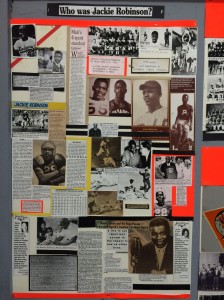By Jon Weisman
It’s no exaggeration to say that Jackie Robinson is the pride of Muir High School, just as he is the pride of the Dodgers and, for that matter, the United States.
So it was a special day for everyone today when this week’s Dodgers Love L.A. community tour (presented by Bank of America) made a stop at Muir, with a screening of portions of Ken Burns’ upcoming “Jackie Robinson” documentary, followed by a Q&A featuring manager Dave Roberts and team historian Mark Langill, moderated by broadcaster Jorge Jarrin.
Many of the four score students in attendance today will graduate from Muir exactly 80 years after Robinson did. But not to worry — his story still resonates.
“I loved the documentary,” said Bryan Barrios, senior captain of the Muir baseball team. “It was very inspiring (and) emotional. I walk around this campus just thinking about Jackie Robinson all the time. Sometimes I can’t believe he came here.”
Ninth-grader Breanna Macklin said viewing the documentary (which will debut in full April 11-12 on PBS) meant the most to her, to see what he went through and how he still became successful. She knew Robinson’s story. But as much as you know it, you never really know it. It still never stops revealing more.
“I was surprised how cruel they were to him,” Macklin said.

The Dodgers today presented Muir with a framed photo and replica uniform of the school’s most famous alum.
The documentary itself brings new information and context to the complexities of Robinson, including how they weren’t limited to his struggles against racial discrimination. Burns takes the time to show the conflict within the African-American world about how best to move forward, and how difficult it could be at times for Robinson to navigate, finding himself at odds at different times with such giants as Paul Robeson and Muhammad Ali.
“You could see him flailing, trying to find his way through all of this tumult,” author and ESPN columnist Howard Bryant said in the program.
But the point was never that Robinson was or should have been perfect. Greatness and a live meaningfully lived don’t come without setbacks. And there is no mistaking how meaningfully Robinson lived his life.
As the Dodgers’ first African-American (as well as their first Japanese-American) manager, Roberts said he does look at his position “as a responsibility.” Two months after his hiring, four weeks before his first full squad officially reports to Spring Training, Roberts showed, in his words to the students, his potential to live up to that responsibility.
“Twenty-eight years ago, I was in your shoes,” Roberts said. “I just want to challenge you all to really have the vision to be great and be leaders. … Find something you love to do, and be great.”
Roberts said that he was a good student, but not a great one. He played sports, but he wasn’t big physically.
“But I was always good to the community and treated people well,” he said. “Even if I never became a Major League Baseball player, I knew I was going to be successful.”
One of Roberts’ intentions as Dodger manager, he noted later, is to continue a culture of “respecting people who have come before us.”
If you doubt the importance of what Roberts represents, Langill offered this reminder. In 1972, Robinson was honored at the World Series for the 25th anniversary of his groundbreaking Major League debut. But Robinson made the point, according to Langill, that he couldn’t really be satisfied until he saw an African American as manager in the dugout.
“Finally, you can play connect the dots,” Langill said.








Comments are closed.